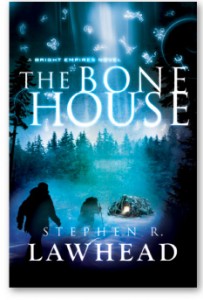 The Shadow Lamp
by Stephen R. Lawhead, Book 4 of a 5-book series, Bright Empires
The Shadow Lamp
by Stephen R. Lawhead, Book 4 of a 5-book series, Bright Empires
Published 2013 by Thomas Nelson, 379 pages
Genre: Multiverse fantasy with a Christian worldview, suitable for teens and adults
Five books is a lot for a series. Devotees of Stephen Lawhead, like me, will of course eagerly pick up each book as it comes out. But it is necessary to do a bit of reviewing before plunging in. There’s just too much to remember.
Kit Livingstone has stumbled through the previous three books slowly getting a little wiser in his search for the Skin Map. Why do Kit and a variety of others want the map? It leads to the Spirit Well, a possible key to conquering death. And Kit has even been there, though briefly. Can he find his way back?
Kit has some loyal compatriots, starting with his former girlfriend Mina, and in this book picks up some more: Cass and Gianni. He’s also got a compatriot who betrayed him before, Haven, and her servant Giles. Will she betray Kit again?
They all decide to look for the Spirit Well using shadow lamps invented by the evil Lord Burleigh that assist traveling to other universes. But it will be a while before more lamps can secretly be made. So they wait in Prague.
But Haven can’t wait. And soon enough Burleigh finds their trail. Is it too late?
Lawhead is a masterful writer. I enjoyed his rich characters and twisty plot. I’m also enjoying all the zillions of possibilities that the multiverse concept gives. With such a long series there are many threads and characters to weave together, and Lawhead does a masterful job. As with any masterful job, there’s always a quibble: one scene didn’t seem to add to the plot in my opinion (concerning how Lord Burleigh found and hired his henchmen).
Read my reviews of all five books in the series: one, two, three, four, five.
This is part of the Christian Science Fiction/Fantasy Blog Tour. Please check out what others are saying about the book.
Julie Bihn
Red Bissell
Thomas Clayton Booher
Thomas Fletcher Booher
Beckie Burnham
Jeff Chapman
Theresa Dunlap
April Erwin
Timothy Hicks
Christopher Hopper
Becky Jesse
Becca Johnson
Jason Joyner
Carol Keen
Rebekah Loper
Shannon McDermott
Meagan @ Blooming with Books
Rebecca LuElla Miller
Mirriam Neal
Writer Rani
Nathan Reimer
Chawna Schroeder
Jojo Sutis
Rachel Starr Thomson
Robert Treskillard
Steve Trower
Rachel Wyant
Phyllis Wheeler
Deborah Wilson
Author Website
– http://www.stephenlawhead.com/
Author Facebook page
– #/pages/Stephen-R-Lawhead/84503526872



